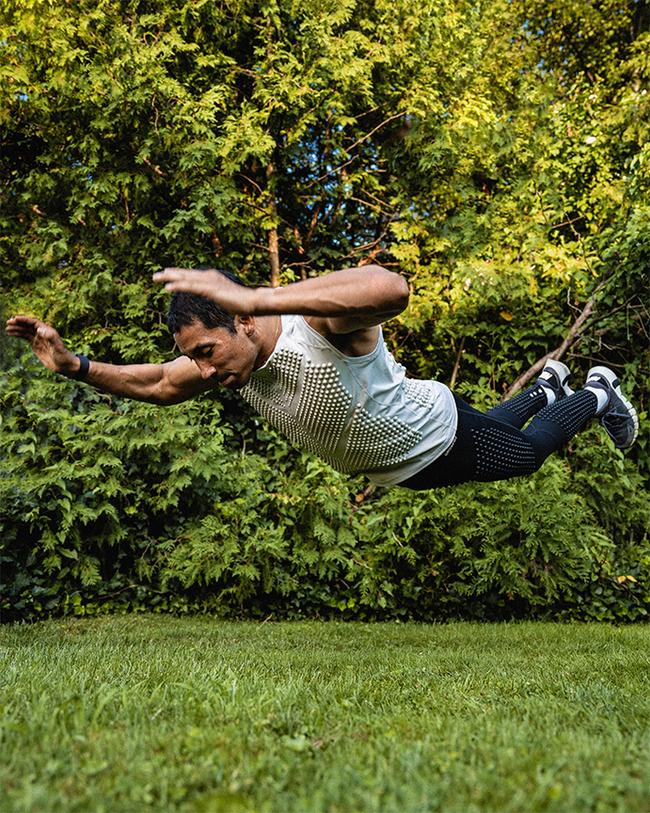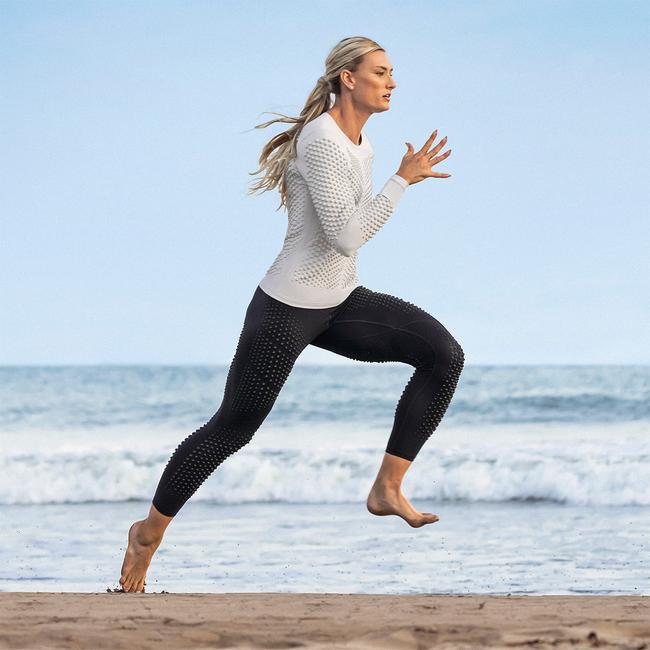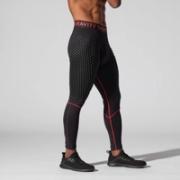Here at OMORPHO, we mention the term “MicroLoad™” a lot and even have an entire page on our website dedicated to it. The principles behind MicroLoad™, or loading your body with small amounts of distributed weight, helped us develop the entire OMORPHO product line for everyday resistance training.
Our Head of Design, Natalie Candrian, previously wrote about how we’ve created better wearable resistance, a.k.a. training with small weights attached to your body, starting with the G-Vest. We’ve implemented the ideas behind MicroLoad™ in our stylish G-Wear by strategically positioning micro-weights across the apparel and targeting key muscle groups. Unlike the heavy weighted backpacks and accessories of the past, the G-Tight, for example, weighs just over one pound. While there isn’t a strict definition for the ideal magnitude(s) of MicroLoad™ that one should use, a common suggestion is 0.5 to 5% of one’s body mass range.
While I’ve also written about how a weighted vest can improve your personal fitness, I want to go deeper into the benefits of MicroLoad™ training (sometimes called “microloading”) itself. Research supports the idea that more weight isn’t always better when it comes to training. Over the past decade, I, along with other biomechanists and researchers, have been studying the effects of MicroLoad™ and how small weights can truly yield big results.
Simply put, resistance training with MicroLoad™ increases the effectiveness of your workouts and helps you realize greater results, without changing anything but what you wear. Here are a few specific benefits of MicroLoad™ and wearable resistance training.
MicroLoad™ does not interfere with your movement.

By keeping weight light and distributed during training, your wearable resistance complements your movement patterns. Even the most complex movements (i.e., a martial arts kick) can be safely performed with this intentionally-light load. Combining it with a comfortable and even weight distribution across the body segment(s) ensures that there’s minimal to no impact (or interference) on your movement mechanics.
MicroLoad™ does not slow you down.

If your sport or activity requires you to move fast, you need to train fast. “Micro” loads allow you to train for sport or activity-specific movements while loaded, with little to no impact on movement speed. This means you can improve your strength with speed-specific resistance training without being slowed down by added weight.
MicroLoad™ increases the effectiveness of your training.
If I had to answer the simple question, “Does MicroLoad™ training work?” The simple answer would be, “Yes.” The only caveat is that it depends on whether you use it correctly and with sufficient frequency. It’s like brushing your teeth. It works, but not if you only do it once per month. Regular training with MicroLoad™ helps you increase the effectiveness of your training and, therefore, gain greater results over time. What this looks like is also different depending on the type of training you do and what you are training for.
MicroLoad can help you reach your fitness goals.
For individuals engaging in exercise for general fitness purposes (i.e., outside of sports or competition), often the important training outcomes are related to greater calorie burn, including fat loss and weight management, strength in functional movements or improvements in cardiovascular fitness. In each of these categories, adding MicroLoad™ to your training can make a significant impact over time.
Evidence for the performance effectiveness of MicroLoad™ training, particularly for athletes, continues to grow. Currently, we know that consistent training with MicroLoad™ and wearable resistance has been shown to improve power output (2,3), jump height; (3) distance (1); speed (2) and acceleration capabilities (1,3); and strength (3) and force production (2). You can read more about this here.
To sum it up, MicroLoad™ training is a new(er) method of resistance training that applies light, wearable weight to your body without encumbering your movements, speed or intensity. It has been shown to increase the effectiveness of sport performance training by providing a targeted approach for adding resistance during complex or high-speed movements. It has also been shown to help maximize the benefits of a fitness session through greater caloric burn, boosting cardiovascular benefits and increasing strength developments over time.
Stay tuned for more posts about MicroLoad™ and wearable resistance training by subscribing to our newsletter for more updates.
References
- Bustos A, Metral G, Cronin J, Uthoff A, Dolcetti J. Effects of warming up with lower-body wearable resistance on physical performance measures in soccer players over an 8-week training cycle. J Strength Cond Res. 2020;34(5):1220-1226.
- Macadam P, Nuell S, Cronin JB, Diewald S, Neville J. Thigh positioned wearable resistance improves 40 m sprint performance: A longitudinal single case design study. J Australian Strength Cond. 2019; 27(04):39-45
- Marriner CR, Cronin JB, Macadam P, Storey A. Redistributing load using wearable resistance during power clean training improves athletic performance. Eur J Sports Sci. 2017;17(9):1101-1109.





